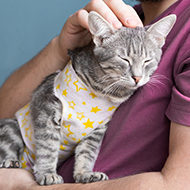Study discovers respiratory pathogen risk factors in cats
“This study supports the on-going need to vaccinate cats against these highly transmissible agents."- Emi Barker.
Research into respiratory pathogen risk factors in cats has revealed that feline calcivirus is the most common upper respiratory tract pathogen among pet cats in the UK.
The discovery was made as part of a study, funded by BSAVA, into the highly contagious oral infectious agents feline calcivirus (FCV), feline herpesvirus (FHV) and Chlamydia felis. The pathogens are considered the main cause of upper respiratory tract disease in cats, but little is known about their occurrence among UK pet cats, and their risk factors for oral carriage.
To investigate this, scientists assessed the prevalence of these pathogens using buccal swabs collected from 430 cats that were enrolled in the Bristol Cats Study.
They detected all three of the major upper respiratory tract pathogens in the sampled cats, with 13.3 per cent testing positive for FCV, 2.1 per cent positive for FHV and 1.2 per cent positive for C. felis.
The data suggested that purebred cats have a higher chance of carrying FCV compared to crossbred cats, as did cats that had current or historical clinical signs of upper respiratory tract disease. Cats that were entire at 12 months and living in a multi-cat household were also found to be at higher risk.
The findings showed that the majority of cats that had FHV or C. felis were also positive for FCV, meaning that any cats suspected of having FHV or C. felis based on clinical signs should also be assessed for FCV. When hospitalising cats, the researchers also advise using disinfectant which has activity against FCV.
Emi Barker, lead author of the study, said: “This study supports the on-going need to vaccinate cats against these highly transmissible agents.
“Background population prevalence also needs to be borne-in mind when investigating and treating cats with upper respiratory disease – for example, calicivirus is going to be a prime suspect, but finding it might not be a slam dunk diagnosis.”
The full study can be found in the Journal of Small Animal Practice.
Image © Shutterstock



 RCVS Knowledge has called on vet practices to audit their post-operative neutering outcomes.
RCVS Knowledge has called on vet practices to audit their post-operative neutering outcomes.